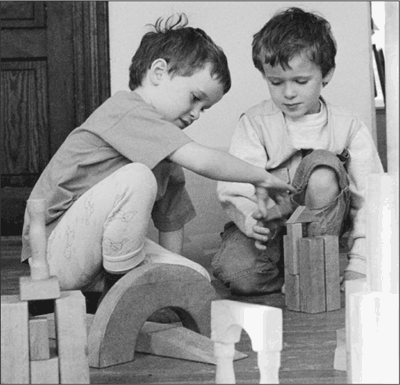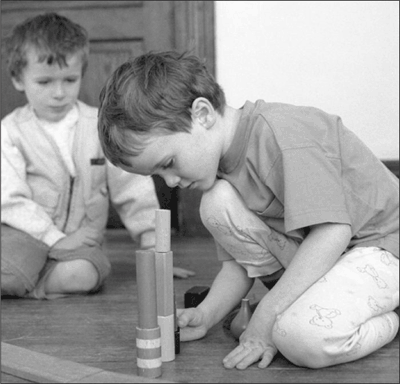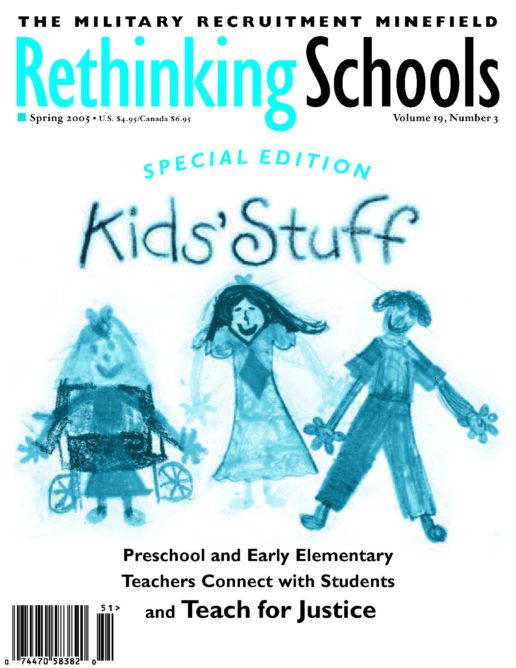Confession
Not only do my students play in the classroom, but it's good for them

I confess: My students play with blocks.
Despite the current obsession with standards and standardized testing, some of us are still letting children play in our classrooms.
Those of us with intimate views of child development experience the physical, social, and intellectual benefits of play. Our opinions contradict a widely accepted view of play as a whimsical activity that contrasts sharply with the disciplined nature of work. But play can be a purposeful, intellectual activity that is hard work.
Block building, with proper guidance, has a great deal of educational value. It can help children acquire literacy, develop social skills, gain experience problem solving, and enhance spatial sense.
I work at a progressive elementary school called Children’s Community School, where block building is an important part of the curriculum from kindergarten through second grade.
My first- and second-grade class’s experience with block building began after a field trip to a local butterfly garden. We had participated in an extensive tour of the garden, compost heap, and cages, where we viewed different stages of the monarch life cycle. Afterward, I wanted the children to build with blocks so I could assess what they had learned on our field trip. It was a way to allow them to process their knowledge while having fun.
“We could build the compost heap!” Ari* volunteered.
“Let’s make the cages where we saw the monarch caterpillars and chrysalises,” added Stacy. The children demonstrated their knowledge of the field trip by working with me to construct a map of the garden grounds. I wrote their ideas onto a chart, which served as a reading lesson. The students signed up to construct the butterfly garden, compost heap, cages, chrysalises and cocoons, and even bathrooms. The vocabulary words the children generated connected to our earlier study of bugs.
Teachers can observe children’s social interactions by having them participate in block building. When children work together to decide which size of blocks to use, where to build, and who should do what, they are practicing skills they will use throughout their adult lives. They are negotiating and resolving conflicts.

Although some educators say it’s predominately boys who gravitate toward blocks, at our school block building is a fundamental part of the curriculum instead of a choice. As a result, many girls become passionate builders and players.
Like any other lesson, teachers need to facilitate building activities. When my students encounter problems, I stop the activity and initiate a discussion. I ask the children to come up with solutions to the problems. Over the course of the school year there’s less discord. The students develop better social skills due to my facilitation and the process of problem solving.
The possibilities for problem solving in block building are limitless. Sometimes the children identify problems, and other times I do. I believe my role as a facilitator is not only to take advantage of “teachable moments,” but also to help my students discuss their interests and concerns.
One teachable moment occurred when we were studying animals that live in and around water. When the class built a community on a river, I noticed that structures blocked the river. I realized this was an excellent opportunity to explore the concept of life cycles. I gathered the children in an open section of the room to discuss this problem.
“The salmon won’t be able to swim upstream!” shouted Billy, when I asked how our building would affect the salmon. The children discussed possible solutions and eventually agreed on raising the bridges above the water. During community block building, two students noticed that our market had run out of food. Several industrious children immediately began coloring and cutting out miniature hams, tomatoes, and carrots for the market.
During our butterfly garden block building, I observed the children learning during play by experiencing different roles and situations. While playing, one student began giving tours of the monarch cages, explaining the life cycle of a butterfly in great detail to her audience. I was surprised to see how closely she followed our guide’s script. Two students drew and cut out jumping spiders for a bug hunt— just like the ones we saw on our garden tour.
Constructing buildings is a disciplined activity that requires planning, geometry, and spatial sense. Unlike paper and pencil, blocks require a different mode of thinking. The graphite line of a pencil is easily manipulated and erased, while blocks retain their form and need to be reconfigured. Yet this rigidity of form doesn’t constrain creativity. I’m continually impressed with the way my students stack and balance the blocks.
I’ve observed students who clearly had mental templates of their buildings before they began construction, like Timothy, who meticulously selected and placed the blocks for the steps of our nature center. Children become very concerned with symmetry, shapes, and the heights of their buildings. Still others seem to improvise, adding and subtracting blocks to their edifices as needed. Throughout the year, their block building becomes more detailed.
Sadly, regimentation of school schedules makes it difficult for teachers to support alternative ways of learning. I believe blocks are a medium and an assessment tool that haven’t gained the recognition they deserve. My students’ participation in this playful yet disciplined activity enhances their language skills, social skills, problem solving, and spatial sense. It’s an important foundation upon which their education is built.
Try it sometime.
*All children’s names have been changed.

